deaths
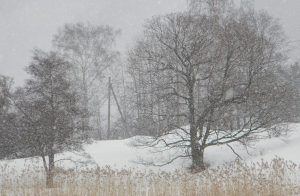 These days, the weather centers can predict storms weeks out. True, they aren’t always as accurate as we would like, but they can also predict corrections and update people with the changes. Of course, it is something we are used to in this day and age, but in 1941, weather centers didn’t exist. That was catastrophic for the people of North Dakota and Minnesota, when a fast-moving and quite severe blizzard hit on March 15th, killing 151 people. The storm came in so quickly that the people had no warning, and as a result far too many lost their lives.
These days, the weather centers can predict storms weeks out. True, they aren’t always as accurate as we would like, but they can also predict corrections and update people with the changes. Of course, it is something we are used to in this day and age, but in 1941, weather centers didn’t exist. That was catastrophic for the people of North Dakota and Minnesota, when a fast-moving and quite severe blizzard hit on March 15th, killing 151 people. The storm came in so quickly that the people had no warning, and as a result far too many lost their lives.
Because of that storm, weather forecasting and reporting systems made important advances that would have prevented the loss of life that occurred due to the sudden storm. The people of North Dakota and northern Minnesota had virtually no warning of the blizzard that was coming, until it swept in suddenly from the west on March 15. In some locations, temperatures dropped 20 degrees in less than 15 minutes. They were hit with 55 mile per hour sustained winds, and gusts reaching 85 miles per hour in Grand Forks and 75 miles per hour in Duluth. The winds 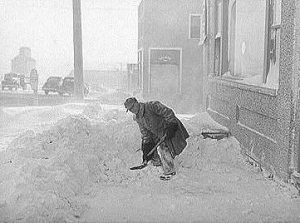 brought blinding snow and huge 7 foot high snow drifts across the states. Most of the victims of the blizzard were traveling in their cars when it hit. Highway 2, running from Duluth, Minnesota to North Dakota, was shut down, as were Highways 75 and 81. Attempts to rescue those stranded in their cars came too late. In one incident, six year old Wilbert Treichel died from exposure to the cold when his parents abandoned their car and attempted to carry him through the blizzard to safety.
brought blinding snow and huge 7 foot high snow drifts across the states. Most of the victims of the blizzard were traveling in their cars when it hit. Highway 2, running from Duluth, Minnesota to North Dakota, was shut down, as were Highways 75 and 81. Attempts to rescue those stranded in their cars came too late. In one incident, six year old Wilbert Treichel died from exposure to the cold when his parents abandoned their car and attempted to carry him through the blizzard to safety.
People attending a basketball game in Moorhead, Minnesota, were stranded at the arena overnight when it was wisely decided that travel was too dangerous for the 2,000 people. Theaters, hotels and stores across the region stayed open through the night to accommodate the many people had visited them, completely unaware that a major storm was approaching. Although the storm was also severe in Manitoba, Canada, only seven people there died because the population was much better prepared for the storm and for dangerous weather in general.
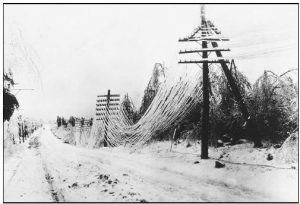
Prior to this time, meteorologists in Chicago were concerned mostly with local weather. It wasn’t that they did not care about the people in surrounding areas, but rather that it was not traditional reporting to report weather for the other areas. In the aftermath of this blizzard, weathermen in North Dakota and Minnesota, who had been under the control of the Chicago meteorology office, which simply paid less attention to events occurring to the north, were allowed autonomy in their reporting. Protected with new technological advances in the wake of the disaster, area residents hoped they would never again be so blind-sided by a winter storm.
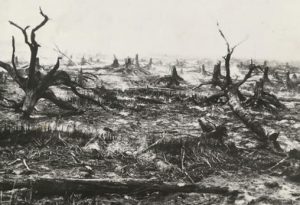 Where there is a forest, there is a possibility of a massive forest fire. The area around Moose Lake in Minnesota, had just such a fire that started on October 12, 1918. The fire, known as the Cloquet-Moose Lake fire, killed hundreds of people and leaving thousands of people homeless. The fire burned a hug area at least 1,500 square miles. The fire, which began at the rail lines near Sturgeon Lake, did the most damage in the Cloquet and Moose Lake areas. This is a region of Minnesota, north of Duluth in the eastern part of the state.
Where there is a forest, there is a possibility of a massive forest fire. The area around Moose Lake in Minnesota, had just such a fire that started on October 12, 1918. The fire, known as the Cloquet-Moose Lake fire, killed hundreds of people and leaving thousands of people homeless. The fire burned a hug area at least 1,500 square miles. The fire, which began at the rail lines near Sturgeon Lake, did the most damage in the Cloquet and Moose Lake areas. This is a region of Minnesota, north of Duluth in the eastern part of the state.
The area was really a recipe for a major disaster of this sort. The timber industry used a crude 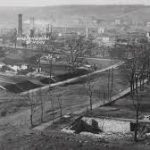 slash method in the thick forests, thus leaving behind dry scraps that were perfect kindling for wildfires. They were not careful where they left the slash either, tending to leave the scraps lying around the rail lines that carried wood from the lumber mills. Train engines of that time often gave off sparks, and when the sparks hit the slash pies, fires were nearly inevitable. The months leading up to October 1918 were very hot and dry, which made matters even worse. The fire began that October 12th, and it quickly spread due to the high winds that day. More than 200 people died in the Moose Lake area, when the fire raced into the community. Many of the local residents tried to escape the raging flames by driving down Highway 73, south of the Kettle River. The
slash method in the thick forests, thus leaving behind dry scraps that were perfect kindling for wildfires. They were not careful where they left the slash either, tending to leave the scraps lying around the rail lines that carried wood from the lumber mills. Train engines of that time often gave off sparks, and when the sparks hit the slash pies, fires were nearly inevitable. The months leading up to October 1918 were very hot and dry, which made matters even worse. The fire began that October 12th, and it quickly spread due to the high winds that day. More than 200 people died in the Moose Lake area, when the fire raced into the community. Many of the local residents tried to escape the raging flames by driving down Highway 73, south of the Kettle River. The  road had a very sharp curve that proved to be too difficult to maneuver for drivers who were speeding away from the flames surrounding them. At least 15 vehicles went off the road within minutes, which resulted in 25 deaths.
road had a very sharp curve that proved to be too difficult to maneuver for drivers who were speeding away from the flames surrounding them. At least 15 vehicles went off the road within minutes, which resulted in 25 deaths.
In all, he fire destroyed 38 towns and villages. The total dead was 453 and another 85 people were seriously burned. The area lost 4,000 houses, 6,000 barns, and 40 schools to the flames.The fire came up so quickly that there was no time to try to get the livestock out, and hundreds of thousands of farm animals also perished in the fire. It was a huge loss for area farmers. In all, the region suffered close to $100 million in damages.
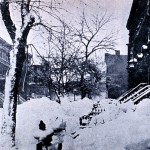 As we sit here, with an early Spring upon us, I find it an odd thing to think about another year that had been rather balmy too. The year was 1888, and things were about to get serious along the northern East Coast. The day began with rain, but as the storm really came at around midnight, the rain turned to snow, and the area began to become a nightmare right before the very eyes of the people in the area. Snowfalls of between 20 to 60 inches were seen in parts of New Jersey, New York, Massachusetts, and Connecticut. The winds howled…sustained winds of more than 45 miles per hour producing snowdrifts in excess of 50 feet. The area railroads were shut down and people were confined to their houses for up to a week. The difficult thing here is that people didn’t have some of the weather predictors that we have these days, so many of them had no idea what was coming their way, and so had far k=less time to prepare for it.
As we sit here, with an early Spring upon us, I find it an odd thing to think about another year that had been rather balmy too. The year was 1888, and things were about to get serious along the northern East Coast. The day began with rain, but as the storm really came at around midnight, the rain turned to snow, and the area began to become a nightmare right before the very eyes of the people in the area. Snowfalls of between 20 to 60 inches were seen in parts of New Jersey, New York, Massachusetts, and Connecticut. The winds howled…sustained winds of more than 45 miles per hour producing snowdrifts in excess of 50 feet. The area railroads were shut down and people were confined to their houses for up to a week. The difficult thing here is that people didn’t have some of the weather predictors that we have these days, so many of them had no idea what was coming their way, and so had far k=less time to prepare for it.
Areas of northern Vermont received from 20 inches to 30 inches in this storm, with drifts reported from 30 to 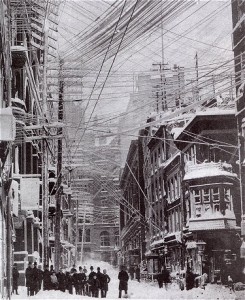 40 feet over the tops of houses from New York to New England. There were also reports of drifts covering 3 story houses. The highest drift…52 feet was recorded in Gravesend, New York. A total of 58 inches of snow fell in Saratoga Springs, New York; 48 inches in Albany, New York; 45 inches of snow in New Haven, Connecticut; and 22 inches of snow in New York City. With the snow came severe winds, with gusts up to 80 miles per hour, although the highest official report in New York City was 40 miles per hour, with a 54 miles per hour gust reported at Block Island. Central Park Observatory, in New York City, reported a low temperature of 6 °F, and a high temperature of 9 °F on March 13…the coldest ever for March. These days Winter Storms have names, but they didn’t then. Nevertheless, the storm was named the Great White Hurricane. It paralyzed the East Coast from the Chesapeake Bay to Maine, as well as the Atlantic provinces of Canada. The Telegraph was disabled because of all the downed lines, isolating Montreal and most of the large northeastern United States cities from Washington DC to Boston for days. Following the storm, New York began placing its telegraph and telephone lines underground to prevent destruction. From Chesapeake Bay through the New England area, more than 200 ships were either grounded or wrecked, killing at least 100 seamen.
40 feet over the tops of houses from New York to New England. There were also reports of drifts covering 3 story houses. The highest drift…52 feet was recorded in Gravesend, New York. A total of 58 inches of snow fell in Saratoga Springs, New York; 48 inches in Albany, New York; 45 inches of snow in New Haven, Connecticut; and 22 inches of snow in New York City. With the snow came severe winds, with gusts up to 80 miles per hour, although the highest official report in New York City was 40 miles per hour, with a 54 miles per hour gust reported at Block Island. Central Park Observatory, in New York City, reported a low temperature of 6 °F, and a high temperature of 9 °F on March 13…the coldest ever for March. These days Winter Storms have names, but they didn’t then. Nevertheless, the storm was named the Great White Hurricane. It paralyzed the East Coast from the Chesapeake Bay to Maine, as well as the Atlantic provinces of Canada. The Telegraph was disabled because of all the downed lines, isolating Montreal and most of the large northeastern United States cities from Washington DC to Boston for days. Following the storm, New York began placing its telegraph and telephone lines underground to prevent destruction. From Chesapeake Bay through the New England area, more than 200 ships were either grounded or wrecked, killing at least 100 seamen.
In New York, all transportation was at a standstill for days, and drifts across the New York–New Haven rail line at Westport, Connecticut took eight days to clear. Partly because of the transportation gridlock, it was decided that they needed a better system, and the first underground subway system in the United States, opened nine years later in 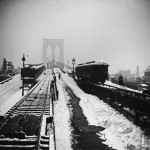 Boston. The New York Stock Exchange was closed for two days…something that almost never happens. Firefighters were unable to get to the fires, and property loss just from the fires was estimated at $25 million. Severe flooding occurred after the storm due to melting snow, especially in the Brooklyn area, which was more susceptible to serious flooding. Efforts were made to push the snow into the Atlantic Ocean. More than 400 people died from the storm and the cold that came with it, including 200 in New York City alone. Among them was former United States Senator Roscoe Conkling. The blizzard also resulted in the founding of the Christman Bird and Wildlife Sanctuary located near Delanson, Schenectady County, New York, which was listed on the National Register of Historic Places in 1970.
Boston. The New York Stock Exchange was closed for two days…something that almost never happens. Firefighters were unable to get to the fires, and property loss just from the fires was estimated at $25 million. Severe flooding occurred after the storm due to melting snow, especially in the Brooklyn area, which was more susceptible to serious flooding. Efforts were made to push the snow into the Atlantic Ocean. More than 400 people died from the storm and the cold that came with it, including 200 in New York City alone. Among them was former United States Senator Roscoe Conkling. The blizzard also resulted in the founding of the Christman Bird and Wildlife Sanctuary located near Delanson, Schenectady County, New York, which was listed on the National Register of Historic Places in 1970.
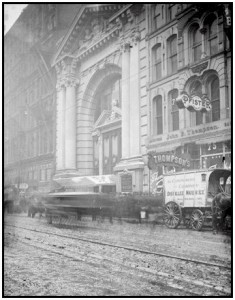 Every day, we benefit from safety measures that have been put in place as a result of a need, or more often a tragedy, that occurred in the past. We give very little thought to things like fire drills, earthquake drills, or even the fire extinguisher on the wall in buildings. We don’t normally think about the fire exit, unless we are looking for the way out of a building and find that this exit is only to be used in case of a fire. I suppose that the reason we don’t think of these things is that we expect the place we are in to be a safe place. There are regulations surrounding the public use of buildings that require that the building meet a certain standard of safety, and most often they do…these days anyway.
Every day, we benefit from safety measures that have been put in place as a result of a need, or more often a tragedy, that occurred in the past. We give very little thought to things like fire drills, earthquake drills, or even the fire extinguisher on the wall in buildings. We don’t normally think about the fire exit, unless we are looking for the way out of a building and find that this exit is only to be used in case of a fire. I suppose that the reason we don’t think of these things is that we expect the place we are in to be a safe place. There are regulations surrounding the public use of buildings that require that the building meet a certain standard of safety, and most often they do…these days anyway.
These safety lessons were not so pleasant to learn for those who came before us and who didn’t survive. Such was the case on December 30, 1903, when the Iroquois Theater in Chicago caught fire and killed 602 people, 572 inside the theater, with the rest dying of the injuries received in the fire. That total included 212 children. You see, the Iroquois Theater was hosting hundreds of adults and school children to a Holiday performance of a play starring the popular comedian, Eddie Foy. The sad thing is that the theater was thought to be fireproof. In reality it was a deathtrap, due to so many safety violations. As a result, the lives of many families were devastated. As I looked at the list of victims, I can’t say that I ran across any I knew to belong in my family tree, but I could be wrong on that too. My family and that of my husband, Bob, spent a lot of time in the Great  Lakes area, so it is entirely possible that my own family lost people due to this tragedy as well.
Lakes area, so it is entirely possible that my own family lost people due to this tragedy as well.
These days, our children think nothing of a fire alarm going off in school. They have several of them a year. when the alarm goes off, they simply follow their training and line up to leave the building. If there were a fire, they would most likely not know it until they were not allowed to go back into the building. Children in earthquake prone areas at taught exactly what to do if the room starts shaking, and they respond automatically, often saving their lives.
The problem with the Iroquois Theater fire, was as simple as the problem with the Titanic. People didn’t think the building could possible burn, or the ship sink. The Iroquois Theater was only open five weeks before it’s total destruction. As a result, lives were lost. In my reading of this tragedy, I found that while the architect wanted every possible safety measure taken, costs had been cut and therefore, the fireproof theater everyone thought they were in, simply did not exist. The theater was over crowded by 400 people, at 2,000 people in a theater designed to hold 1,600. They stairway to the fire escape hadn’t been finished yet. exit doors had been designed to be pulled open, and with the crowd of fear stricken people, the press was to much, and the escape, completely blocked. Iron gates closing off some of the stairways were locked, and people tried jumping out the window…to their deaths unfortunately. In some  places the bodies were stacked 10 high with people attempting to crawl over each other to get out. In desperation the fire department set up a bridge of sorts to get people out. Some got out, some didn’t.
places the bodies were stacked 10 high with people attempting to crawl over each other to get out. In desperation the fire department set up a bridge of sorts to get people out. Some got out, some didn’t.
I don’t know why we humans always seem to think that something we build could be indestructible, when in reality, much of what we build is, in one way or another, flawed. I think that one of the best things we can do for our families, is to make sure they all know how to get out of a building safely. We can hope that the architect, contractor, workers, and inspectors all did their job properly, but we must remember that they are only human too, and mistakes can be made. If people know not to panic, they can get out safely more times than not, but panic…most often results in tragedy. And that is what happened in the Iroquois Theater in Chicago on December 30, 1903…panic and a complete disregard for the elementary rules of safety.

